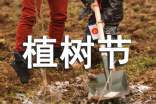- 相关推荐
植树节活动英语作文
下面是大学网小编为大伙整理的有关植树节的英语范文,供大伙参考。

范文一
The first Arbor Day took place on April 10, 1872 in Nebraska. It was the brainchild of Julius Sterling Morton (1832-1902), a Nebraska journalist and politician originally from Michigan. Throughout his long and productive career, Morton worked to improve agricultural techniques in his adopted state and throughout the United States when he served as President Grover Cleveland's Secretary of Agriculture. But his most important legacy is Arbor Day.
Morton (photo, right) felt that Nebraska's landscape and economy would benefit from the wide-scale planting of trees. He set an example himself planting orchards, shade trees and wind breaks on his own farm and he urged his neighbours to follow suit. Morton's real opportunity, though, arrived when he became a member of Nebraska's state board of agriculture. He proposed that a special day be set aside dedicated to tree planting and increasing awareness of the importance of trees. Nebraska's first Arbor Day was an amazing success. More than one million trees were planted. A second Arbor Day took place in 1884 and the young state made it an annual legal holiday in 1885, using April 22nd to coincide with Morton's birthday.
In the years following that first Arbor Day, Morton's idea spread beyond Nebraska with Kansas, Tennessee, Minnesota and Ohio all proclaiming their own Arbor Days. Today all 50 states celebrate Arbor Day although the dates may vary in keeping with the local climate. (State Arbor Days) At the federal level, in 1970, President Richard Nixon proclaimed the last Friday in April as National Arbor Day. Arbor Day is also now celebrated in other countries including Australia. Variations are celebrated as 'Greening Week' of Japan, 'The New Year's Days of Trees' in Israel, 'The Tree-loving Week' of Korea, 'The Reforestation Week' of Yugoslavia, 'The Students' Afforestation Dayy' of Iceland and 'The National Festival of Tree Planting' in India. Julius Sterling Morton would be proud. Sometimes one good idea can make a real difference.
For the homeowner, Arbor Day is an excellent opportunity to take stock of the trees on your property and plan for the future. Inspect your trees. Note any broken branches or evidence of disease or insect infestation. Think about how planting new trees might improve the look of your property or provide wind or heat protection. Take a trip to your local nursery to see what's available and to get new ideas. Walk around your neighbourhood. Are there any public areas where tree planting or tree maintenance might make a real difference to your community? Talk with your neighbours. Find out what their opinions are. And, oh yes, plant a tree.
范文二
THE IMPORTANCE OF ARBOR DAY
On Arbor Day, particular attention is drawn to the part trees play in our lives. It's not just a day to plant trees and then forget the gesture for another twelve months. Planting a tree one day is no credit to us if, during the rest of the year, we neglect to care for it and those already growing. Our thought on Arbor Day should be an expression of enduring feeling, thought and action and not just one single, isolated flame of interest.
In schools and other community groups, this day can be celebrated in many different ways.
·By planting trees or shrubs in school grounds, along neighbouring streets or in civic parks.
·By 'adopting' a patch of bush, with the landowner's consent, and caring for it by removal of weeds, rubbish, etc, by prreparing firebreaks and by fencing and making paths to reduce trampling.
·By presenting a play or mime about trees in the history of Australia.
·By completing a project about certain types of trees (eg. jarrah, boab, karri) or a famous tree like the Gloucester Tree near Pemberton.
·As a class activity or common interest group go on a visit to a bush area with a spokesperson to explain the characteristics of plant species and their niche in the natural environment.
·Collect some tree seeds, germinate them in a classroom, and plant out the seedling.
·Carry out identification of trees in a specific part of your school or neighbourhood. A tree labelling ceremony could also be arranged.
·Compile a list of everyday objects that are made of wood or wood-based materials, and find out how the wood was processed, where it came from and whatever else you can.
Trees and shrubs, whether native or introduced to WA, provide opportunities for the interest and study by the whole community, and when we walk around our own neighbourhood or drive through the countryside, we can appreciate the importance of such a diversity of plants to the well being of humanity.
[植树节活动英语作文]
【植树节活动英语作文】相关文章:
关于植树节英语作文11-02
关于植树节的英语作文范文09-18
用英语表达植树节10-31
植树节活动通知11-03
植树节活动背景08-19
银行植树节活动09-01
北京植树节活动07-10
植树节活动总结08-25
学生植树节活动09-13
植树节活动纪实06-02